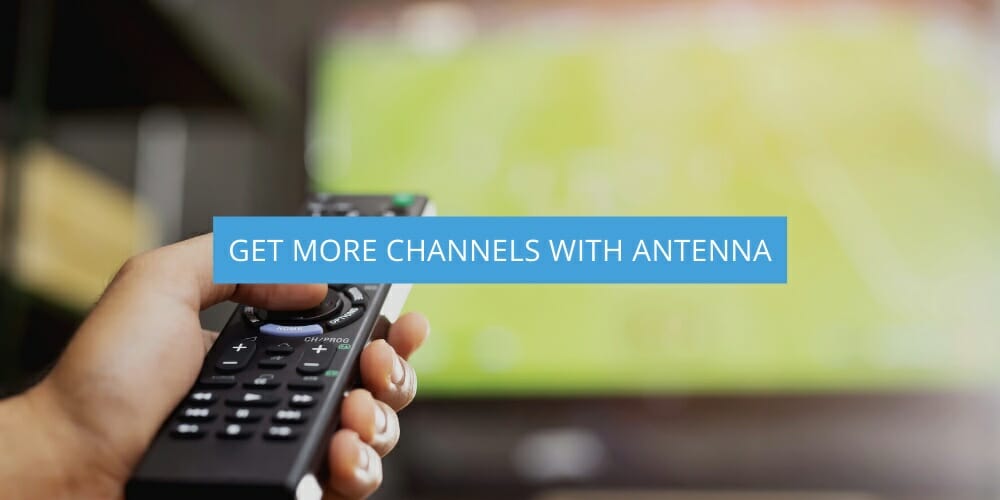Do you have a weak or degraded antenna signal? If you’re a cord-cutter using over-the-air (OTA) TV signals, it can be an issue. It can be extremely frustrating when our favorite stations lose their reception due to OTA antenna interference and degradation!
You should find a way to improve your antenna signal to get more channels. And in this article, I’ll give you some ideas and shed some light on how to get more channels with an antenna.
Ways to Get More Channels with an Antenna

Certain channels are available when the antenna is in a specific position. But when you move it to a different position, new channels appear, and the ones you had before vanished. Hence, finding the best way to get more channels with an antenna can be challenging.
Here are some helpful hints for increasing your antenna reception and getting more antenna channels.
Reposition Your Antenna as High as You Can
The higher your antenna is the better chance of picking up weaker signals and avoiding other obstacles that might interfere with OTA signals. When using various signal finder tools, you are asked about your antenna’s estimated height. Moreover, you can mount outdoor antennas on your roof or at higher mounting locations. As a result, you’ll receive more channels than indoor antennas.

You should determine the highest possible location for your antenna while also considering other factors, such as cable length and possible signal reflections. Also, installing an indoor antenna should be near a window and, if possible, an outside-facing wall. However, please don’t use an excessively long cable because it will degrade your signal.
Align Your Antenna Correctly to the Nearest Broadcast Tower
Before buying an antenna, you should figure out where your area’s closest broadcast towers are. You can find TV signals in your area using various tools and websites. That way, you’ll determine the antenna you need and how powerful it must be. You can also identify whether you need a longer-range antenna (possibly one with amplifiers).
Furthermore, if you’re having trouble picking up your local ABC affiliate, you can use those tools and websites to determine the tower’s location. With that, you’ll know if you should move your antenna to a window or an outside-facing wall that faces that tower. You can also use it to determine antenna strength. For example, if most of the essential towers in your area are within a 20-mile range, then you’ll only need a 20-mile reception range antenna. As a result, you’ll be able to make a more economical decision and a more cost-effective investment. (1)
Protect Your Antenna from the Weather
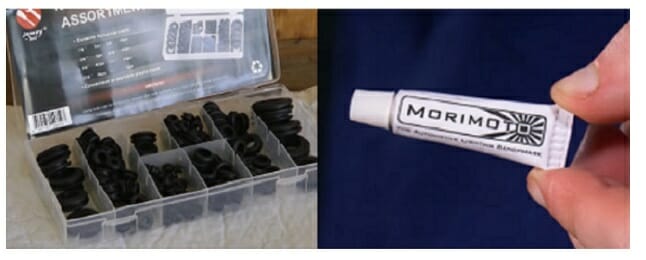
To make your connections weatherproof, I recommend using the following:
- Grommets – are used to seal off and protect cables for extended periods. It’s built with PVC and other high-quality rubber materials, such as EPDM or TPR, and you can install it easily on any cable.
- Dielectric Sealant – dielectric materials do not conduct electricity and do not allow electromagnetic waves to pass through them. Hence, you can avoid signal interference by sealing the cable core with a dielectric sealant.
Additionally, you can use high-end compression connectors to replace your coaxial connections. These attachments are newer than solder or crimp, but they are becoming increasingly popular because they provide superior weatherproofing and other benefits. However, compression connectors are more expensive, and crimping tools are required. But they work great to optimize your antenna reception and handle the highest available frequency.
Moreover, examine your cable’s condition. The coax cable’s center conductor may become nicked as it gets older. A signal loss will occur as the connector starts to oxidize. Signal interference can arise when the dielectric foam in the middle degrades. Furthermore, the outer plastic and rubber materials are prone to wear and tear. Hence, if the connectors are old and crimped, or if the cable appears thinner than the new ones, it’s best to replace them.
Tip: Replace your older coax cables with RG6 cables. They are of a thicker gauge and have more prominent conductors. It has shielding and insulation for high-bandwidth, high-frequency signals. To avoid interference, they also have thicker dielectric insulation.
Remove Electrical Interference from Your Home’s Interior and Exterior
Heaters, refrigerators, and even LED and fluorescent lights in your home can cause interference. Therefore, position your antenna as far away from that interference as possible. However, having many electrical devices in your house will not be easy. In this case, I suggest you purchase a power conditioner. It can assist in cleaning dirty power, reducing EM and RF interference in your home, and protecting your antenna from power surges.
It would be best to consider 4G (or 3G and 5G) signal interference, which can cause your TV signal to be distorted or broken. With that, check your antenna to see if it has signal filters. You can buy products like an LTE Filter for TV antennas if it doesn’t. It blocks signal interference by filtering out radio signals outside the standard television broadcast band. Also, you won’t have to worry about the filter affecting your phones or tablets because it only affects signals traveling between your antenna and the TV. (2)
Ensure That Your Antenna is Well-grounded
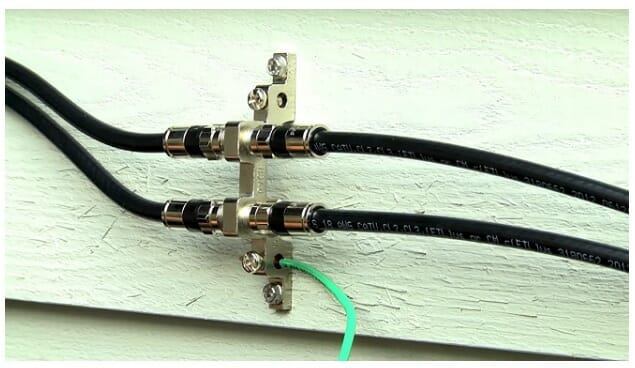
An adequately grounded antenna is crucial because it directs all electromagnetic interference to the ground and avoids damage from lightning and thunderstorms. Contrary to popular belief, electricity will always try to return to its source (while using the earth/ground as a critical path).
To properly ground your antenna, you can use coax ground blocks, which are relatively easy to come by and inexpensive.
Install an Antenna Preamplifier
An antenna-mounted preamplifier compensates for signal loss in the coaxial cable that connects the antenna to the television. It is essential to overcome signal loss if your location is far from the TV transmitter towers. But preamplifiers can be counterproductive in areas where the TV transmitters are relatively close because they can cause signal levels to be too high and distorted.
In addition, a professional field strength meter is the most accurate way to measure the level of the received signal. However, if it is a one-time installation, it may be overkill. Alternatively, you can use a TV station locator tool to see what antenna channels are nearby.
Note: Ensure your antenna isn’t already amplified, as a preamplifier won’t work with amplified antennas.
Install a Distribution Amplifier for Your Antenna
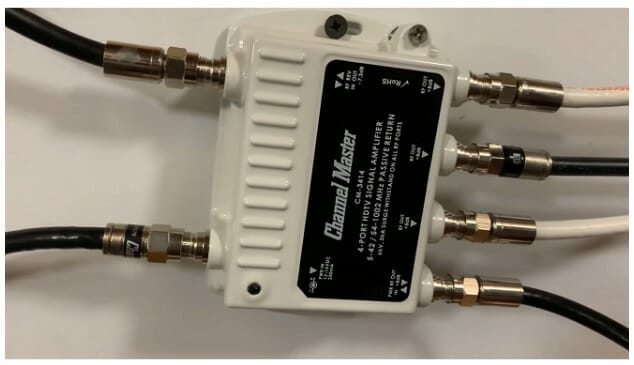
Your signal will split if you have multiple TV outlets, resulting in signal degradation. If you have three TVs in your house and only one antenna, you’ll need a distribution amplifier. Naturally, you’ll require one if you own a hotel, motel, or other similar establishments.
As a general guideline:
- Using a 2-way splitter will lose you around 4dB of signal
- Using 3-way or 4-way splitters will lose you around 8dB of signal.
- Using an 8-way splitter will lose you around 15dB of signal.
Also, remember that signal loss will still occur even if a splitter’s ports aren’t in use. Hence, a distribution amplifier is significant as it boosts the received signals’ strength to their original (or even higher) levels before splitting them. The longer the distribution line, the more it produces a signal loss. So, it’s critical to position your distribution amplifier in the middle between the TV sets.
Use an Antenna Totor That is Motorized
An antenna rotor is a motorized device that allows us to move the TV antenna in any direction. This rotation is usually done with remote control and is more common for outdoor antennas that are difficult to reach. A control unit is placed near the television and is connected to the rotor device via a multi-conductor wire. When TV signals are received from various directions, a motorized antenna rotor comes in handy. In such cases, you can’t receive all these signals with a single fixed-position antenna.
Stacking vs. Ganging of antennas
Antenna stacking increases your antenna’s signal reception/gain by stacking two or more antennas together or one on top of the other. The two signals will then be combined using a signal joiner or coupler. Stacking tends to work best when two or more antennas are touching metal-to-metal. On the other hand, antenna ganging is when you point two or more different antennas at two or more different TV transmitter towers. Then, use a coupler or signal joiner to combine the incoming signals.
When stacking or ganging your antennas, keeping the cables short is critical. It ensures that the two (or more) signals are “in phase.”
Enhance Your TV Tuner
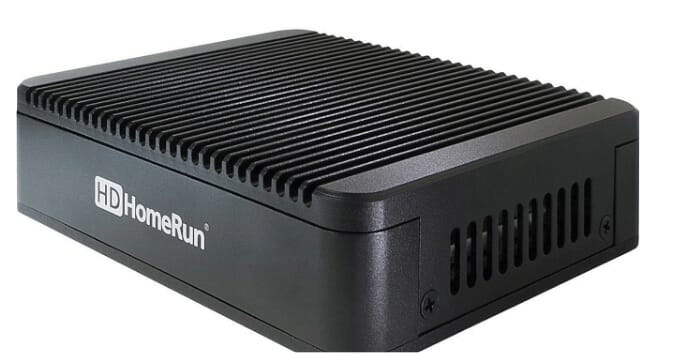
Most TV sets these days come with built-in TV tuners. However, they aren’t always the best in terms of quality, and investing in a dedicated network tuner (or tuner box) could significantly improve your antenna’s reception. Purchasing an HDTV network tuner can completely disconnect or untether your antenna from your television. You won’t have to worry about the distance between your antenna and your TV set, and you won’t need a splitter.
A dedicated tuner box is built with higher-quality components than your TV’s built-in tuner and will be fine-tuned to stricter specifications. As a result, the picture quality would be better and more consistent.
Horizontally Lay Your Antenna
My antenna was taped to the wall at one point in my previous apartment and fell to the floor. Surprisingly, it received better reception on the floor than vertically on the wall. So, try laying your flat antenna horizontally to see if it helps.
My friend also got the best reception by tapping their antenna to the ceiling. So, start with the prominent places (near windows and outside walls), but also try laying it flat horizontally, especially if you live near tall trees, mountains, or tall buildings. These obstructions can cause the TV signal to enter your home in unusual and non-obvious ways.
Incorporate Some Metal
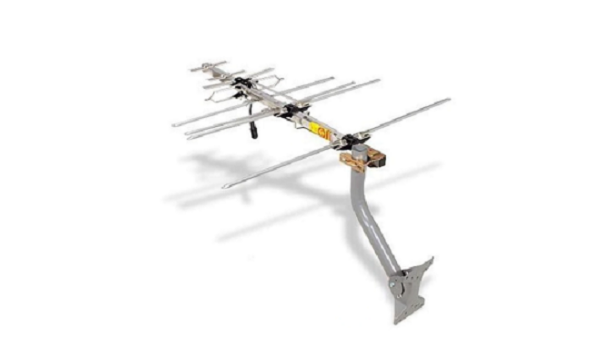
This technique will not work for antennas enclosed in plastic. It’s only for metal antennas; if you own one, try attaching another piece of metal or wire to it. You can use wire or other metallic objects such as hangers and the like.
Re-scan Regularly
After a few months of using an antenna, I noticed that I occasionally got new channels when I did a new channel scan. Locations, channels, and transmitter power are all changed regularly by television stations. Therefore, I highly recommend re-scanning regularly. There’s a chance you’ll get some channels you didn’t have previously!
Consider Using or Removing a Reflector
A reflector behind your antenna can help if your TV signals come from the same direction. You can improve your antenna’s reception by placing pie tins and metal baking sheets behind it. It might work for you in some situations.
On the other hand, if you’re using an antenna with a reflector grid, try removing it. Because the reflector blocks all signals from the backside, removing it may allow you to gain more channels if your signals come from two different directions.
Thus, all you have to do now is try them out to see which works best for your antenna. Which is better, the one with or without a reflector?
Antenna Upgrade
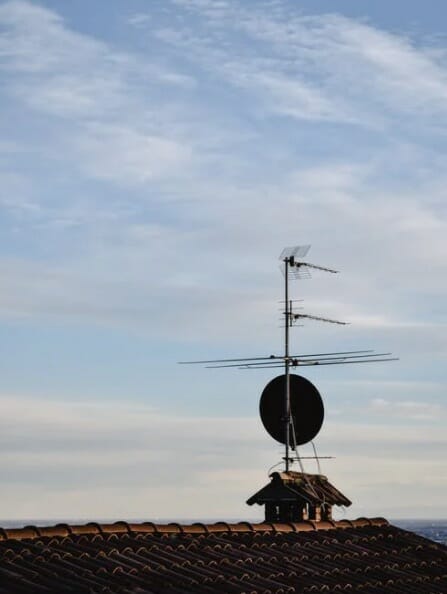
Another factor to consider is the direction from which the television signals originate. The TV transmission towers are typically clustered in a general direction. As a result, a unidirectional antenna is often the best option. Also, we recommend using an outdoor antenna in most cases unless it’s impossible for you, such as living in an apartment complex.
FAQs
When to use an antenna rotor?
Cord-cutters who live between two TV markets will benefit from an antenna rotor. We can receive TV signals from both markets by manually rotating the antenna. An antenna rotor is the most cost-effective solution because we can’t point our antenna in both directions simultaneously.
When to not use an antenna rotor?
An antenna rotator may not be necessary if your antenna serves more than one television set in your home. For example, suppose your children are watching TV, and you suddenly rotate the antenna, resulting in signal loss. Furthermore, antenna rotors are more susceptible to wear and tear because they are typically installed outside. Thus, follow the manufacturer’s instructions for rotor device care.
Wrapping Up
In this digital TV era, it’s essential to ensure your signal reception’s quality. With that, those methods and tricks I’ve mentioned on how to get more channels with an antenna will surely help you with it.
Please check other learning and product guides below;
- What is the best TV antenna signal booster
- How to boost an outdoor TV antenna signal
- Best TV antenna amplifier
Check also the video below.
References
(1) cost-effective investment – https://www.sciencedirect.com/topics/engineering/efficient-investment
(2) 4G, 3G, 5G – https://www.verizon.com/about/our-company/5g/difference-between-3g-4g-5g

